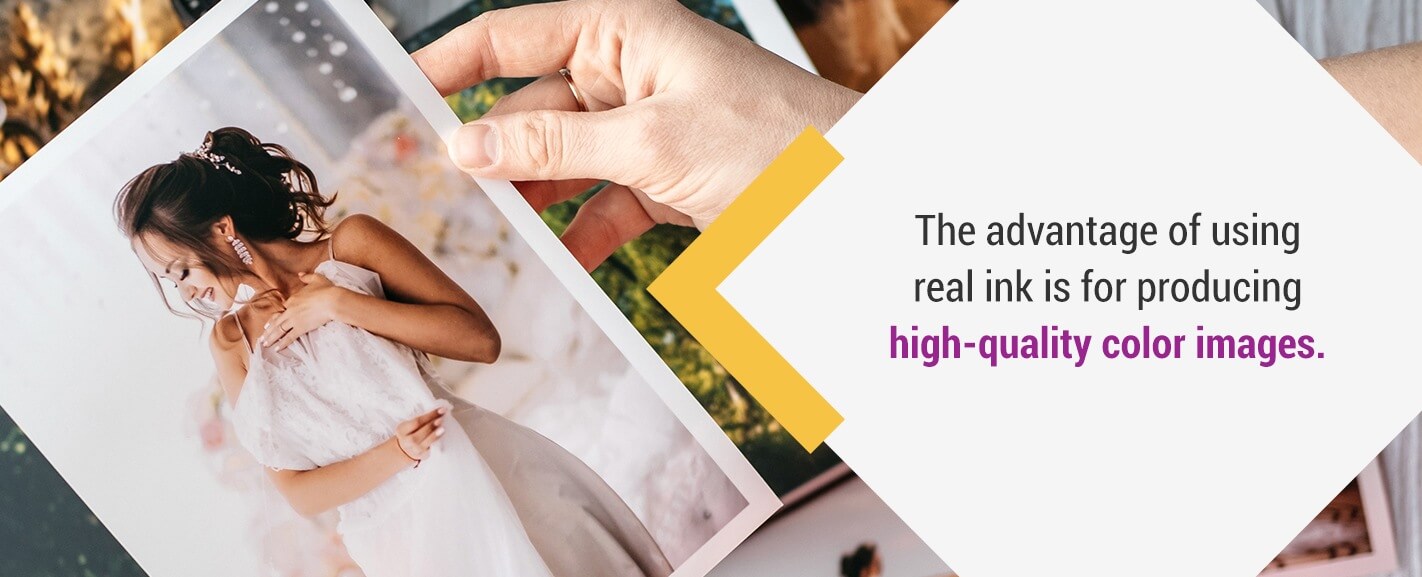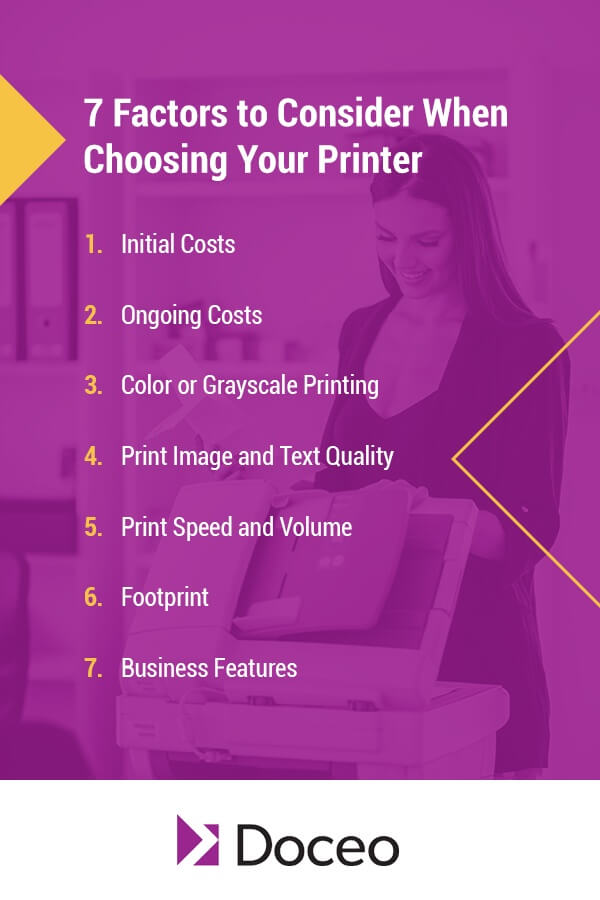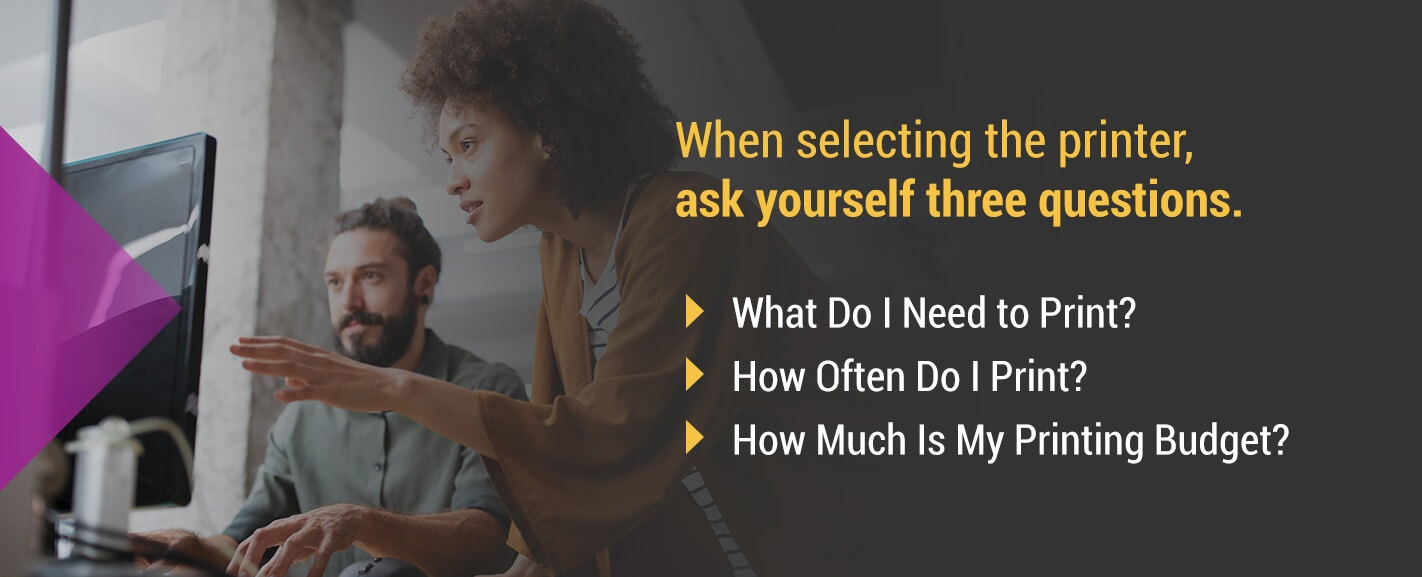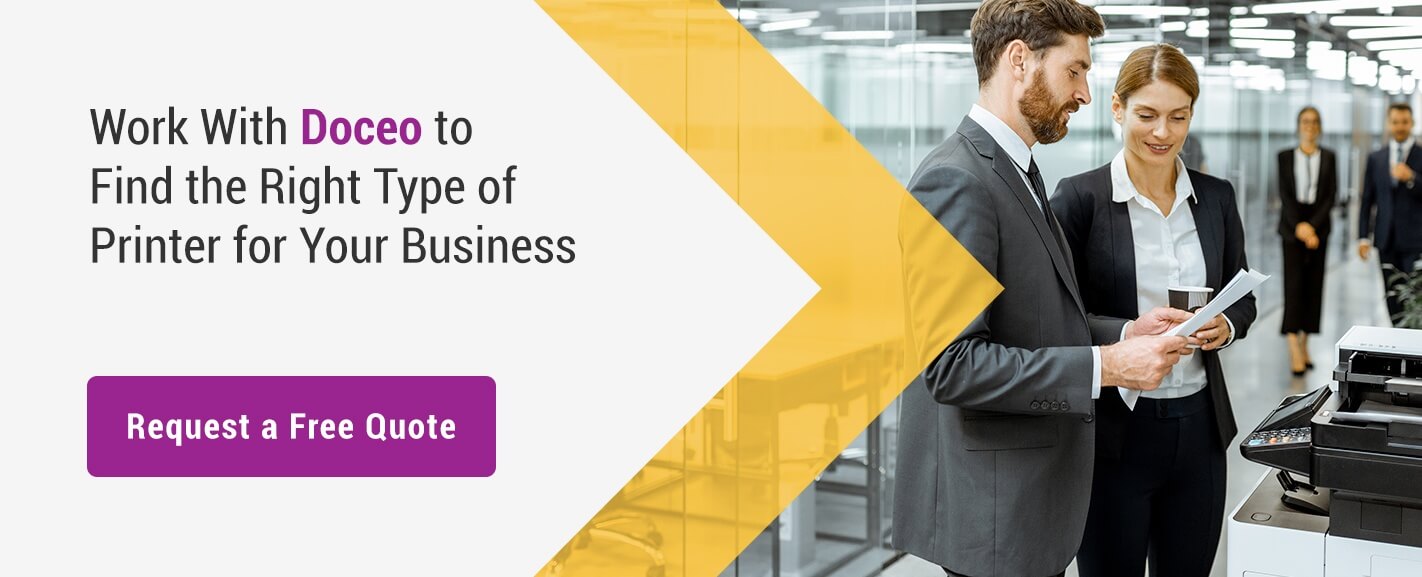Inkjet vs. Laser Printers: Which One Is Right for You?
December 29, 2020
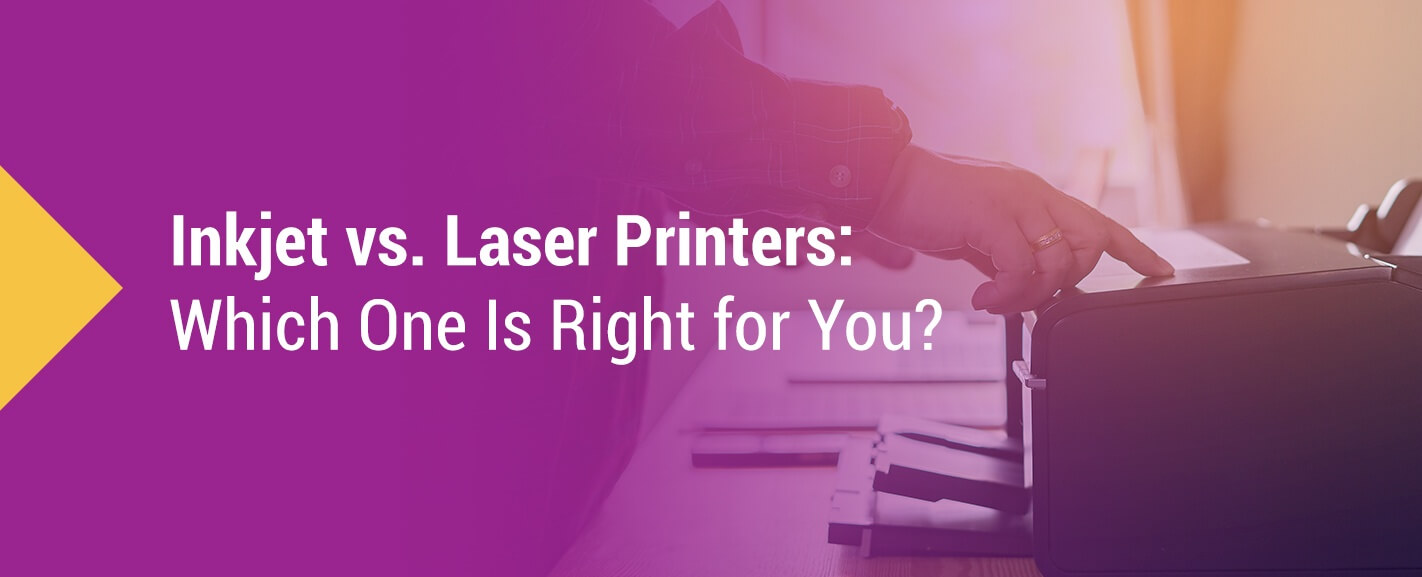
Is inkjet or laser better? The main difference between an inkjet and a laser printer is how they work. An inkjet printer literally jets ink droplets onto the blank page. A laser printer uses a laser beam to melt toner powder onto printer paper. Each comes at a different price point, print speed and image quality. They also have several factors that significantly impact the printer’s lifetime cost. Which one is right for you? Learn more about these two types of printers and their unique applications and features to find out.
Inkjet vs. Laser Printers
Laser and inkjets have very different methods for applying text and images to a blank page. Because of these differences, they also produce different results and offer unique benefits.
What Is an Inkjet Printer?
An inkjet printer has a small nozzle that sprays microscopic ink droplets onto your printer paper. The technology is simpler, and it originated before laser printers came on the scene. Inkjet printers tend to be cheaper and smaller. The ink cartridges usually cost less than a laser printer’s toner cartridges.
Inkjet printers use two ink types — pigment-based ink and dye-based ink. The pigment-based ink is higher quality and likewise costs more. Dye-based ink takes longer to dry and set, which might make it more likely to smudge. Since the ink goes on wet in either case, certain types of less-absorbent paper may smear with inkjet printers.
The advantage of using real ink is for producing high-quality color images. Photos will look better on an inkjet printer thanks to the ink’s vibrant hues and the printer’s ability to blend colors smoothly. If you’re planning on printing photos often, your best bet could be an inkjet printer specifically labeled as a photo inkjet printer. These printers will produce detailed images with blacker blacks and high tonal variety. Their pigment-based ink resists fading and will adhere well to glossy photo paper and textured stationery alike. These features make photo inkjet printers useful for small businesses printing marketing collateral.
An inkjet printer needs far less warmup time to begin printing, making it excellent for quickly printing the occasional document. The ink cartridges can also be refilled or recycled, which reduces waste and saves you money. They’re also smaller and simpler to maintain than their laser printer cousins.
Inkjet printers have a few downsides. While the cartridges are cheaper, the ink itself is more expensive. The printer uses more ink, especially during the self-cleaning process, resulting in a higher lifetime cost. They don’t print at high speeds, which makes it harder to print at high volumes. If you don’t use your printer regularly, the ink may dry out.
What Is a Laser Printer?
A laser printer prints by fusing dry toner powder to your printer paper. The inner workings are a bit more complicated, involving a laser, mirror and photo-sensitive drum, alongside a few other technical components. All you really need to know about the laser printing process is it produces crisp, sharp lines and text and is still quite adept for mid-grade color images.
As you can imagine, the more complicated technology comes with a heftier price tag for both the printer and the toner cartridges. Don’t let this hold you back, though! A laser printer’s sophisticated engineering is less wasteful and prints at a lower cost per page. Most businesses save in the long run with laser printers.
Laser printers are generally the preferred choice for small businesses, schools, law firms and the like. They can print much faster than inkjet printers. This feature makes a huge difference for law firms printing out complicated legal documents or teachers printing out entire textbooks. Any small business that prints primarily text documents, with the occasional graphic, at high volumes will appreciate the extra speed. Laser printers are also suitable for small fonts and fine lines.
On the downside, they’re a bit harder to maintain. That’s not usually a problem for offices that lease their printers. For example, with Doceo’s RateLock program, your machine lease, maintenance, service, parts and toner all come bundled at one fixed monthly rate. It won’t cost extra if the printer needs repairs. Laser printers also take longer to warm up and have a larger footprint in the office.
What about LaserJet vs. inkjet? LaserJet is the model name for the original laser printer, developed in the 1980s for office use by one of our technology partners, Hewlett-Packard. Modern HP LaserJets are still on the market today, and they’re just one of the many laser printer options available to businesses like yours. While you’ll certainly benefit from choosing a household name like HP, most of the LaserJet’s benefits are similar to other laser printers from our reliable technology partners.
7 Factors to Consider When Choosing Your Printer
What should you look for in a printer? The top priorities will depend on your organization and application. In some areas, an inkjet may better fit your needs. In other cases, a laser printer has the right features for your applications. Consider these seven factors to narrow down your choices.
1. Initial Costs
For most small businesses, the initial investment is a deciding factor when adopting new technology. You’ll find high- and low-end models among both inkjet and laser printers. However, in the general price range for inkjet vs. laser, the inkjet is more affordable.
Shopping around for printer pricing can be confusing because it’s easy to find basic laser and inkjet printers available for around the same price. The difference, however, is a basic inkjet printer will print in both black and white and color. A similarly priced basic laser printer will probably only print in grayscale.
It’s also important to treat your printer investment differently than other IT purchases. While items like desktops and monitors are one-time purchases, printers are different. The real cost comes from the ink, which is a recurring purchase. If your budget can accommodate it, it may be better to go with a higher initial cost for a more ink-efficient printer.
2. Ongoing Costs
The ongoing costs for printers involve maintenance, replacement parts and ink or toner. While not usually factored into the price of your printer, you’ll also need to replenish your paper stock.
The industry standard for representing ongoing costs is a printer’s cost per page. It’s calculated by dividing the cartridge price by the page yield, or the number of pages per cartridge. While inkjet cartridges cost less, you also get a much smaller page yield. The result is higher costs per page. Laser printer cartridges are more expensive but have a higher page yield, so you’ll end up saving in the long run.
Another critical aspect of the ongoing cost is the amount of wasted ink. Inkjet printers must have regular maintenance and cleaning cycles, which sometimes use as much ink as everyday printing. The amount of ink wasted increases when printers see intermittent use. The ink efficiency varies widely between brands and models.
One comparison study found an efficient inkjet model wasted about $3.40 in ink annually for maintenance cycles, while another used $158. The initial cost of both printers was almost the same. Another option is to avoid wasted ink by opting for a laser printer. Laser printers don’t use toner for cleaning cycles, which eliminates this cost.
Unfortunately, 64% of small and medium businesses can’t track their ongoing printer costs and usage. As such a significant part of your company’s overall IT budget, your recurring ink costs are crucial. Doceo’s print management services help businesses like yours understand their printer and ink usage and optimize these ongoing costs.
3. Color or Grayscale Printing
Another way businesses save money is by choosing black-and-white printers. Both inkjet and laser printers come in black-and-white only versions, usually at a lower price point. You’ll find benefits and drawbacks to color and grayscale. For example, printing flyers and brochures in black and white could limit their effectiveness. Color ink doesn’t have to be prohibitive, either. The right printer vendor may lower your company’s color ink costs.
When choosing between inkjet and laser printers, it’s helpful to consider whether you need color printing frequently or plan to print primarily in black and white. For color jobs, an inkjet printer is the best choice. For black and white, you may be better off with the crisp text and efficient black toner usage laser printers provide.
4. Print Image and Text Quality
While both inkjet and laser printers can produce excellent images and text, each one has an edge over the other. An inkjet printer will print better graphics and pictures, and a photo inkjet printer will render photographer-quality images. A laser printer has the advantage when it comes to text, offering sharp, crisp lines. While this isn’t a concern with the right paper, an inkjet could make text appear fuzzy on certain printer paper types.
A business that uses their printers to print hard copies of their branded presentations or flyers may benefit more from an inkjet printer. Another company, which needs to print and read large text documents, might opt for the laser printer. If you’re looking to save paper by printing at smaller font sizes, a laser printer will also come out on top.
5. Print Speed and Volume
For a business that prints many copies, speed is vital. It wastes company time to sit and wait for a large batch of documents to land in the output tray. It’s a surprising amount of time wasted, too. In the United States, at an office with a shared central printer, the average employee waits three minutes per document. While it might not seem like a lot, it adds up to 13 hours per year per employee.
Laser printers are faster and designed for large batches of documents. While you wait a little longer for the warmup, once the first document prints, the next one comes out in no time. For large document volumes, your office will save lots of time. Inkjets are a bit slower, partially because the ink must dry to prevent blurring. When you print small batches on occasion, an inkjet can win you back some time with almost no warmup required.
Another aspect of the printer’s volume capabilities is how much it can print at once. Printing too many documents with a printer in a given timeframe could wear it down. Most printers list a maximum monthly duty cycle and a recommended monthly duty cycle to provide you with a feel for the volume they can accommodate. The maximum number is the amount your printer can handle without causing damage. The recommended number is the volume you should print at to maintain optimal efficiency. Laser printers generally have much higher monthly duty cycles than inkjets.
6. Footprint
Whether you have the entire floor to yourself or a tiny shared office space, your printer’s footprint can be an important decision factor. After all, if you only have room for the printer in your already-crammed supply closet, it must be nice and compact.
In general, commercial printers are a bit bigger than home office printers. For the extra space, you get a multifunction printer that can hold more paper, staple documents and also make copies. In a size comparison of laser printers vs. inkjet, inkjets are on the more compact side. While compact laser printers exist, most are heavier and bulkier than inkjets.
7. Business Features
When it comes to printers, you may need to consider more than its ability to render quality printed graphics and text. Your printer needs to fit with the other workflows at your office. Bigger paper trays might be necessary for high-volume printing and copying. Or, maybe you need a high-capacity printer cartridge to avoid frequent shopping trips to restock ink or toner. Since laser printers have their roots in business applications, they’re likely to include these enhanced features that can help make your company more efficient.
Another thing to think about is the printer’s cybersecurity features. These devices handle sensitive documents all day long and connect to most computers in a company’s network, making them quite enticing to cyberattackers. A shocking 60% of businesses have lost data through printer security breaches.
Laser printers are more likely to have the advanced security features your business needs to protect itself. Commercial inkjets from the right vendor will have these features as well. You might also consider managing your IT services under the same roof as your printer vendor. Doceo offers full-service IT solutions that pair perfectly with our selection of secure laser and inkjet printers.
Which One Is Right for You?
So, is a laser or inkjet printer better? After understanding the differences between inkjet and laser technology, the next step is deciding which one is right for your business. When selecting the printer, ask yourself three questions.
1. What Do I Need to Print?
Do you usually print text or images?
Your answer will likely depend on the type of organization you are. A small business like a store might print colorful graphics for their seasonal sales using an inkjet. A nonprofit or place of worship might also need full-color flyers and brochures to promote their upcoming fundraisers and events. Meanwhile, a law firm uses laser printing for contracts, transcripts and other text-based documents that need to be sharp and easy to read. Schools may print anything from text-based quizzes and class resources to colorful posters for student clubs or teacher bulletin boards.
Different departments within your organization may also have different printing needs. Marketing might need an inkjet for full-color, high-quality image printing. Human resources and accounting can get away with black-and-white printing while benefiting from a laser printer’s crisp, readable text.
2. How Often Do I Print?
While many small businesses find it challenging to track printer usage, a reasonable estimate to go by is your current printer paper and ink cartridge replenishment schedule. Those purchasing records can give you an estimate of your printed pages per month. Is it closer to 500 or 3,000? Inkjets are better suited for lower volumes and less frequent printing. Laser printers work fast for high-volumes and regular printing.
3. How Much Is My Printing Budget?
Every organization has different factors influencing their budget. For some companies, the equipment budget is separate from office supplies like paper and ink. Other companies lump them together and can easily focus on lifetime cost during decision making. Some companies might not have the room in the IT budget to invest in a laser printer, even though it will save money in the long run. Other companies have a limited office supply budget, making an inkjet’s high cost per page harder to justify.
Is a laser printer cheaper than an inkjet printer?
As a rule of thumb, an inkjet is more affordable upfront and more expensive over time. A laser printer costs more at first and evens out with time, thanks to lower costs per page. A laser printer may also last a few more years, helping you stretch your startup investment. Look at specific models to see the individual cartridge prices and costs per page.
Work With Doceo to Find the Right Type of Printer for Your Business
At Doceo, we partner with top-name printer brands to provide you with the right solutions at the right budget. We can meet many image and text quality demands and propose hardware for your facility’s printing needs. Our solutions include multifunction printers and copiers and compact commercial desktop printers. If you want a little more control over your company’s printing expenses, we can combine your printing hardware with our managed print services to help you save anywhere from 15% to more than 30% of your current printing costs.
To receive a customized proposal from one of our Technology Advisors, request your free quote and managed print services assessment today.

